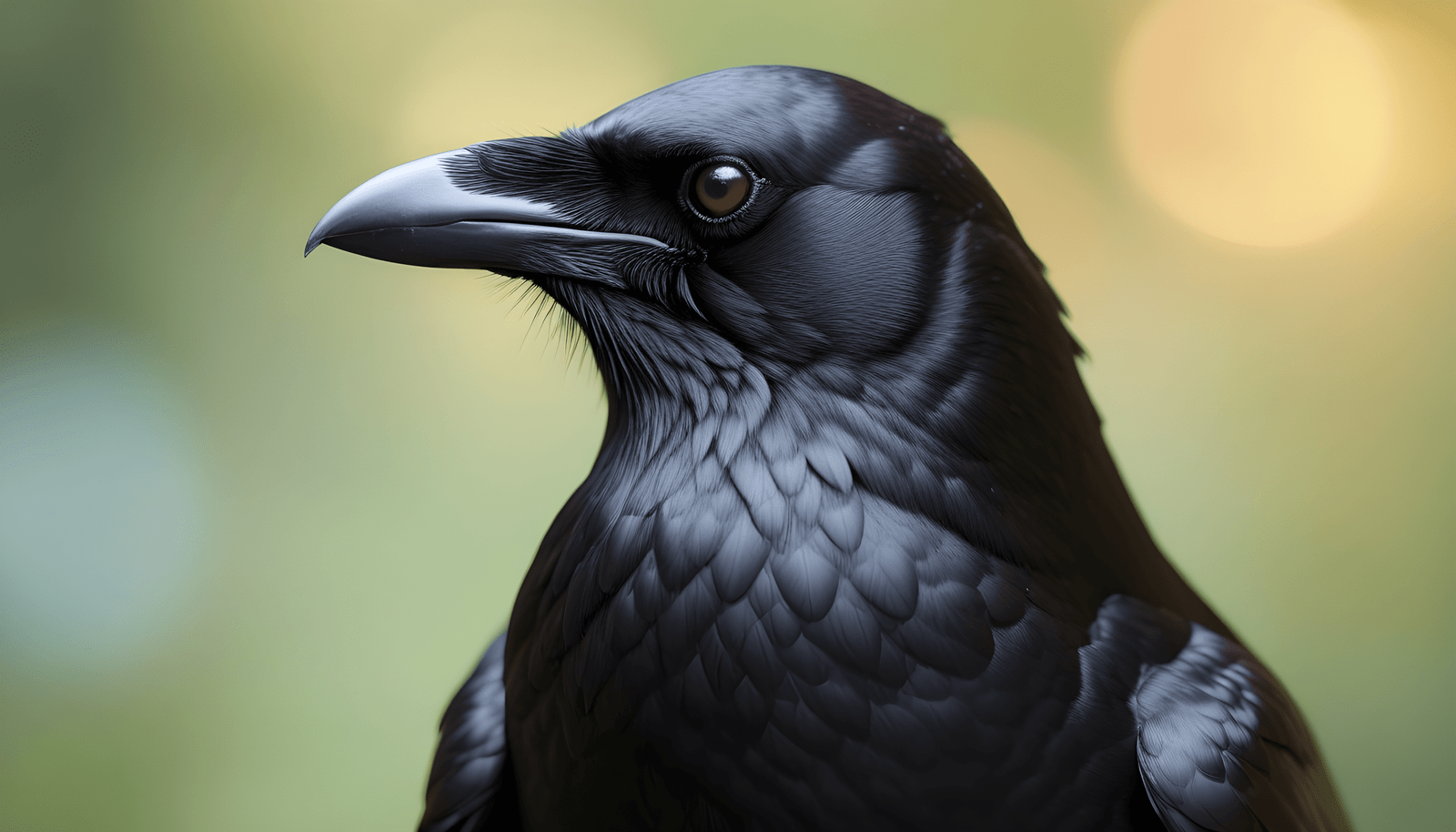Unleashing the Potential: Corvus Moneduloides Lesson RP 1831 – The New Caledonian Crow
December 29, 2023 | by BlackCrow.com

The Fascinating Corvus Moneduloides
Introduction to the New Caledonian Crow
The New Caledonian Crow, scientifically known as Corvus moneduloides, is a remarkable species of crow found in the remote islands of New Caledonia in the southwestern Pacific Ocean. This crow species has gained significant attention and admiration due to its exceptional intelligence and unique problem-solving abilities.
Overview of Corvus Moneduloides Lesson RP 1831
Described by René Primevère Lesson in 1831, Corvus moneduloides has captured the interest of scientists and researchers worldwide. This crow species exhibits remarkable behavioral traits and cognitive skills, making it a subject of extensive study and observation.
With a body length of approximately 38 centimeters (15 inches) and weighing around 200 grams (7 ounces), the New Caledonian Crow is slightly smaller than some other crow species. It has predominantly black feathers, a strong beak, and a distinct curved profile.
The New Caledonian Crow’s intelligence and problem-solving abilities have been a subject of fascination and intrigue. These crows have displayed an impressive aptitude for tool usage, exhibiting behaviors such as crafting and using sticks as tools to extract insects from tree bark. This remarkable ability sets them apart from many other avian species.
Researchers have conducted numerous studies to understand the cognitive capabilities of Corvus moneduloides. These studies have revealed their ability to solve complex puzzles and demonstrate a high level of problem-solving skills. They are known to exhibit an understanding of cause and effect relationships, use tools to create novel solutions, and display advanced problem-solving strategies.
The insights gained from studying the intelligence and behavior of the New Caledonian Crow have far-reaching implications. They provide valuable insights into avian cognition, evolution, and the understanding of animal intelligence as a whole.
The conservation status of the New Caledonian Crow, efforts to protect the species, and the future outlook for its survival will be explored further in the following sections. Stay tuned to learn more about this remarkable avian species and the efforts dedicated to its conservation.
Unique Characteristics
The New Caledonian Crow, scientifically known as Corvus Moneduloides Lesson RP 1831, possesses a set of distinctive physical features and behavioral traits that set it apart from other crow species.
Physical Features of the New Caledonian Crow
The New Caledonian Crow is a medium-sized bird with an average length of about 45 centimeters (18 inches) and a wingspan of approximately 75 centimeters (30 inches). It has predominantly black feathers, a stout beak, and striking bright blue eyes. One notable feature of this crow is its unique, slightly arched bill, which sets it apart from other members of the Corvus genus.
Behavioral Traits and Intelligence
The intelligence of the New Caledonian Crow is a remarkable characteristic that has captivated researchers and bird enthusiasts alike. These crows exhibit a high level of problem-solving abilities and tool usage, making them one of the most intelligent bird species known to date.
Studies have shown that New Caledonian Crows are capable of using tools to extract food from crevices, such as using sticks to extract insects from tree bark or using leaves as probes to catch prey hiding in small holes. This ability to fashion and use tools demonstrates their exceptional cognitive skills and adaptability.
Additionally, these crows display a remarkable level of innovation and flexibility in their problem-solving behavior. They have been observed using a variety of creative techniques to overcome obstacles and obtain food. For example, they have been seen bending wire hooks to retrieve food from containers or using multiple tools in a sequence to achieve their goal.
The New Caledonian Crow’s advanced problem-solving abilities are thought to be closely linked to its relatively large brain size compared to other bird species. This intelligence has been attributed to the unique ecological challenges the crows face in their natural habitat, such as the need to extract insects from tree branches using tools.
Understanding the unique physical features and impressive intelligence of the New Caledonian Crow provides fascinating insights into the capabilities and adaptability of these remarkable birds. To delve deeper into the studies conducted on the New Caledonian Crow, refer to our article on studies on the New Caledonian Crow.
Unleashing Their Potential
The New Caledonian Crow, scientifically known as Corvus Moneduloides Lesson RP 1831, possesses remarkable abilities that set it apart from other crow species. These intelligent birds have demonstrated impressive tool usage and problem-solving abilities, showcasing their potential in the avian world.
Tool Usage and Problem-Solving Abilities
One of the most fascinating aspects of the New Caledonian Crow is its ability to use tools. These birds have been observed fashioning tools from twigs and plant stems to extract prey from hard-to-reach areas. They create hooked tools by carefully shaping and modifying branches, demonstrating a high level of cognition and problem-solving skills.
In addition to tool fabrication, New Caledonian Crows exhibit ingenious problem-solving abilities. They can solve complex puzzles and engage in tasks that require multiple steps and strategic thinking. For example, in an experiment, these crows were presented with a transparent tube containing a treat that was out of reach. They quickly devised a solution by using a short stick to retrieve the snack, highlighting their resourcefulness and adaptability.
Examples of New Caledonian Crow Intelligence
The intelligence of the New Caledonian Crow is further exemplified by their ability to understand cause and effect relationships. In a study conducted by researchers, these crows were trained to drop stones into a water-filled tube to raise the water level and obtain a floating reward. Through trial and error, the crows learned to drop the stones strategically, demonstrating an understanding of the consequences of their actions and the desired outcome.
Furthermore, these remarkable birds have also shown their ability to use tools in novel ways. In an experiment, they were presented with a series of tasks that required them to use tools in unconventional manners. The crows quickly adapted and devised innovative solutions, showcasing their ability to think outside the box and display flexible problem-solving skills.
The tool usage and problem-solving abilities of the New Caledonian Crow have captivated researchers and wildlife enthusiasts alike. These intelligent birds continue to surprise and impress with their remarkable cognitive capabilities. To learn more about the studies conducted on the New Caledonian Crow, refer to our article on studies on the New Caledonian Crow.
By unraveling the potential of the New Caledonian Crow, scientists are gaining valuable insights into avian intelligence and the evolutionary significance of cognitive abilities. The continued research and understanding of these exceptional birds contribute to our knowledge of animal behavior and cognition.
Insights from Research
Scientific studies on the New Caledonian Crow (Corvus moneduloides Lesson RP 1831) have provided valuable insights into the behavior and intelligence of this remarkable bird species. Researchers have conducted numerous experiments and observations to understand the cognitive abilities and problem-solving skills of the New Caledonian Crow.
Studies on the New Caledonian Crow
Researchers have carried out extensive studies to investigate the intelligence and problem-solving capabilities of the New Caledonian Crow. These studies often involve presenting the crows with complex tasks that require them to use tools or demonstrate innovative problem-solving strategies.
One well-known study involved a task where the crows had to use sticks or other objects to retrieve food from a narrow tube. The crows demonstrated remarkable dexterity and problem-solving abilities by fashioning specialized tools from twigs, leaves, and other materials to extract the food successfully. These studies have highlighted the New Caledonian Crow’s ability to use tools in ways that were previously thought to be unique to humans and a few other species.
Findings and Implications
The research on New Caledonian Crows has revealed several fascinating findings and implications. Here are some key insights:
-
Tool Usage and Innovation: The New Caledonian Crow is renowned for its exceptional tool usage and innovation. These birds exhibit the ability to create and modify tools to solve intricate problems and access hard-to-reach food sources. Their tool-making skills involve intricate manipulation of objects and show a high level of cognitive flexibility.
-
Insightful Problem-Solving: Studies have demonstrated that New Caledonian Crows possess advanced problem-solving abilities. They can quickly analyze a situation, devise a strategy, and adapt their behavior accordingly. This cognitive flexibility has been attributed to their large brain size relative to their body size.
-
Social Learning: New Caledonian Crows also exhibit social learning behaviors, allowing knowledge and skills to be passed down from one generation to the next. Young crows observe and learn from experienced individuals within their social groups, leading to the transmission of innovative tool-use techniques.
-
Comparative Cognitive Research: The cognitive abilities of the New Caledonian Crow have attracted interest from researchers studying animal intelligence. By comparing the problem-solving capabilities of crows to other species, scientists gain insights into the evolution of complex cognition and the factors that contribute to cognitive development.
These findings have broad implications for understanding the evolution of intelligence and the cognitive abilities of animals. The research on New Caledonian Crows continues to shed light on the remarkable cognitive capacities and adaptive behaviors of this avian species.
Understanding the results of these studies helps us appreciate the incredible cognitive abilities of the New Caledonian Crow. The insights gained from this research contribute to our understanding of animal intelligence and have implications for fields such as comparative cognition, animal behavior, and evolutionary biology.
Conservation and Future Outlook
The conservation of the New Caledonian Crow is of utmost importance to ensure the long-term survival of this remarkable species. Let’s take a closer look at the conservation status of the New Caledonian Crow and the efforts being made to protect and study this unique bird.
Conservation Status of the New Caledonian Crow
The New Caledonian Crow (Corvus moneduloides Lesson RP 1831) is native to the island of New Caledonia in the Pacific region. Currently, the species is classified as “Endangered” on the International Union for Conservation of Nature (IUCN) Red List of Threatened Species. The population of New Caledonian Crows has been declining due to various factors, including habitat loss, predation, and human activities.
The primary threat to these crows is the loss and degradation of their natural habitat. Deforestation, particularly for logging and agriculture, has resulted in the destruction of the forests that the crows rely on for nesting and foraging. Additionally, the introduction of non-native predators, such as rats and cats, has had a detrimental impact on the New Caledonian Crow population.
Efforts to Protect and Study the Species
Recognizing the importance of conserving the New Caledonian Crow, several conservation organizations, researchers, and local communities have initiated efforts to protect and study this species. These efforts aim to better understand the behavior, ecology, and conservation needs of the New Caledonian Crow while implementing measures to safeguard their habitats.
Conservation initiatives focus on preserving the remaining forested areas that serve as critical habitats for the crows. This includes establishing protected areas, implementing sustainable land-use practices, and raising awareness about the importance of conserving these unique birds.
Research on the New Caledonian Crow continues to expand our understanding of their intelligence, tool usage, and problem-solving abilities. By studying their behavior and cognitive capabilities, scientists gain valuable insights into the evolutionary significance of intelligence in birds. This research also contributes to conservation efforts by highlighting the importance of protecting the New Caledonian Crow and its habitat.
To ensure the future survival of the New Caledonian Crow, it is essential to promote responsible land management practices, control the spread of invasive species, and support ongoing research and conservation initiatives. By fostering a greater understanding and appreciation for this remarkable species, we can work towards securing a brighter future for the New Caledonian Crow.
For more information on other crow species, such as the Pied Crow, White-Necked Raven, or American Crow, visit our blog.
RELATED POSTS
View all


